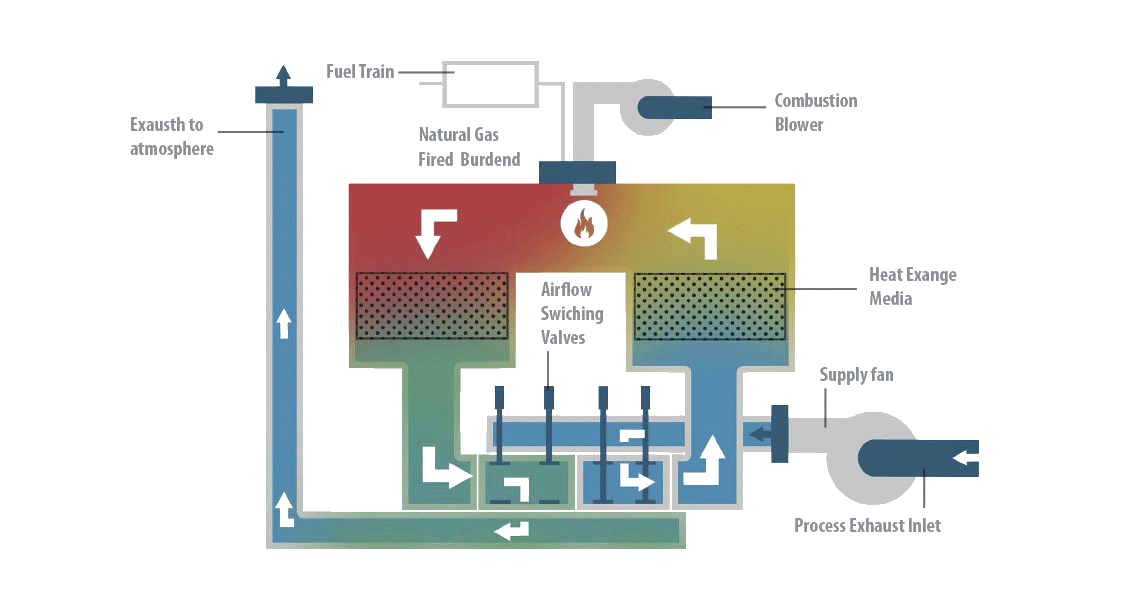Condorchem Envitech Offer
Condorchem Envitech designs and builds regenerative thermal oxidizers according to each specific application, with the most common equipment being:
- Two chambers oxidizers (with or without a clearinghouse)
- Three chambers oxidizers
- More than 3 chambers to treat very high flows. Equipment with 3 or more chambers are usually used in those cases in which a large continuous load is needed without losing treatment capacity, and also in the thermal destruction of halogenated solvents.
Our regenerative thermal oxidizers
Technical characteristics
- Volumes of air between 10,000 and 100,000 m3/h can be treated.
- The concentration of solvent cannot exceed 11,000mg/Nm3.
- Concentration of solvents for autothermic operation: 1.3-1.7 g/Nm3.
- The operating temperature of the equipment is 750ºC.
- Long-duration ceramic medium.
- 200 mm of internal insulation for saving energy.
- Thermal Efficiency > 95%.
Main components
- Combustion chamber.
- Main fan.
- Burner and combustion air fan.
- Ceramic bed.
- Chimney.
- Operation and maintenance platform.
- Insulation.
- Process valves.
- Purge System.
Advantages
- Adaptable to a large variety of air flows
- Allows treating a wide variety of VOCs
- Both the operating costs and the maintenance costs are low
- High thermal efficiency
- Residues are not generated during the process
- Recovery of energy generated for external processes
Applications
Regenerative thermal oxidation is applicable to all processes liable to produce VOC emissions, which are very numerous, and generally belonging to the following industrial sectors:
- iron and steel industry
- plastic industry
- food industry
- timber industry
- paint, varnish and lacquer industry
- livestock industry
- pharmaceutical industry
- cosmetics industry
Introduction to regenerative thermal oxidation
The most widely used treatment for the removal of volatile organic compounds (VOCs) in industrial emissions is regenerative thermal oxidation.
The presence of VOCs in emissions requires a treatment that removes them as they are dangerous compounds. VOCs are classified into 3 groups, depending on their effects on people and the environment:
- Compounds that are highly dangerous for people: benzene, vinyl chloride and 1.2 dichloroethane.
- Class A: Potentially very harmful to the environment; e.g. acetaldehyde, aniline and trichlorethylene.
- Class B: They represent less risk to the environment. Acetone and ethanol belong to this group, among others.
VOCs are all those organic compounds that exist in a gas or very volatile liquid state at ordinary room temperature. In practice VOCS are all those organic compounds that have a vapor pressure equal to or higher than 0.01 kPa or an equivalent volatility in the particular conditions of use at 20ºC. VOCs usually have less then twelve carbon atoms in their chain and contain other elements such as oxygen, fluoride, chlorine, bromine, sulphur or nitrogen.
Although there are more than 1,000 different VOCs, the most abundant in the air are methane, toluene, n-butane, isopentane, ethane, benzene, n-pentane, propane and ethylene. They are compounds are generated in industrial processes in which organic solvents (such as acetaldehyde, benzene, aniline, carbon tetrachloride, 1,1,1-trichloroethane, acetone, ethanol, etc.) are used.
A RTO or regenerative thermal oxidizer is ideal for:
- Air volumes from 10,000 to 150,000 m3/h.
- Medium or high concentrations of solvents.
- Ability to purify a wide variety of solvents.
Functioning/operation of regenerative thermal oxidation
Regenerative thermal oxidizer operation: Regenerative thermal oxidation destroys VOCs by converting them into CO2 and H2O. The process is carried out inside towers filled with ceramic material in which the pollutants are oxidized at 750ºC. The system has a thermal efficiency greater than 95%, such that the consumption of gas to maintain the temperature is reduced.
How does a regenerative thermal oxidizer work: This equipment has a system of conical closure valves, thanks to which a very high purification efficiency is achieved and the risk of leakage of untreated air is avoided. Thanks to this system the equipment can remain closed during the night shift or weekends, thus maintaining a high temperature and therefore a rapid launch, with low consumption by the equipment.
Thermal oxidizer design: The regenerative thermal oxidation is very versatile as regards the flow to be treated, between 2,000-100,000 Nm3/h, which is ideal for medium-high concentrations of VOCs (0.3-10 g/Nm3) and optimal for a great variety of VOCs.
Thermal oxidizer how it works




